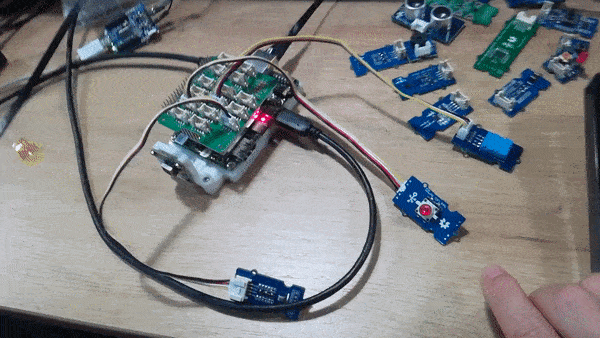Create more AI possibilities with Grove PiHAT and NVIDIA Jetson Nano
If you want to use Grove sensors with Jetson Nano, grab the grove.py Python library and get your sensors up in running in minutes!
NVIDIA Jetson Nano Developer Kit is an AI computer for makers, learners, and developers that delivers the power of modern AI in a small, easy-to-use platform. At Seeed Studio, not only you can get Jetson Nano quickly in hands , we provide Grove Base HAT for Raspberry Pi and Base HAT for Raspberry Pi Zero to help you create more AI possibilities.
If you want to use Grove sensors with Jetson Nano, the best way is to grab the grove.py Python library and get your sensors up in running in minutes! Currently there are more than 20 Grove modules supported on Jetson Nano and we will keep adding more.
What is Grove?
Grove is an open source, modulated, and ready-to-use toolset. It takes a building block approach to assemble electronics. Compared with the traditional, complicated learning method of using a breadboard and various electronic components to assemble a project, Grove simplifies the learning process significantly.
There are already more than 280 Grove modules and each one comes with clear documentation and demo code to help you get started quickly.

You can connect Grove modules using Base HAT for Raspberry Pi or Raspberry Pi Zero with Jetson Nano.

For details about how to install the Grove.py library:
https://github.com/Seeed-Studio/grove.py/blob/master/README.md#installation
Grove Installation Guide
(If you are familiar with the Linux operation system, you can skip this guide and directly refer to the link provided above.)
You only need to perform below steps in a brand new Jetson Nano official Image (click here for Jetson Nano Quick Start Guide), make sure your network works well.
sudo apt-get update
sudo apt-get install curl
Now you can start the installation of grove.py
Step1:
curl -sL https://github.com/Seeed-Studio/grove.py/raw/master/install.sh | sudo bash -s –
Please pay attention to check the final execution result when installing. If FAILED is displayed and you are unable to solve the failure by yourself, please submit new issue in the current repository. Please describe the issue in detail.
Step2:
git clone https://github.com/Seeed-Studio/grove.py
cd grove.py
# Python2
sudo pip install .
# Python3
sudo pip3 install .
Run Grove on Jetson Nano:
After a successful installation, you can use the Grove modules based on the support list of Jetson Nano.
1. First, you need a Grove Base Hat for Raspberry Pi :
The pin header of Jetson Nano is compatible with Pi, however, the function is not completely compatible. Please refer to the table provided by Seeed Studio for the compatibility of specific functions.
The Grove Base Hat is connected like this:

Please pay attention to the pin alignment, do not insert to the wrong position, otherwise it may cause damage to the Grove Base Hat, even the damage of the Jetson Nano Board.
2. Plug in the Grove module.
If it is an I2c module, you can execute it on the Jetson Nano terminal:
sudo i2cdetect -r -y 1
Check if the corresponding I2c address can be scanned. If the scanning failed, please pay attention to the wiring.
3. Execute the corresponding python script command.
Noted that the execution of the python script requires root privileges. For example, when driving an OLED Display 1.12 inch (V1.0) module, you need to do this:
cd grove.py
sudo python grove/display/sh1107g.py
The Grove.py directory is the git repository that was previously downloaded at install time. Usually Oled will display some program-predefined content.
Demo and Software support
We made a demo kit and provided software support for the demo kit.

The Groves included in the kit:
- OLED Display 1.12 inch – v1.0
- 12 key capacitive i2c touch sensor(MPR121)
- 3-Axis digital accelerometer (ADXL372)
- UV sensor VEML6070
- Thumb joystick v1.1
You can download the software here:
https://github.com/linux-downey/jetson_nano_demo_kit_example
Connect to Coral as well!
grove.py Python library for Grove devices also support Coral Dev Board now
This is a blinking button demo with the Coral Dev board. Code can be found here.
import time from grove.gpio
import GPIO
led = GPIO(12, GPIO.OUT)
button = GPIO(22, GPIO.IN)
while True:
if button.read():
led.write(1)
else:
led.write(0)
time.sleep(0.1)

For any new product ideas, please feel free to let us know what you want to see in the forum, we will carefully listen to and take action!



